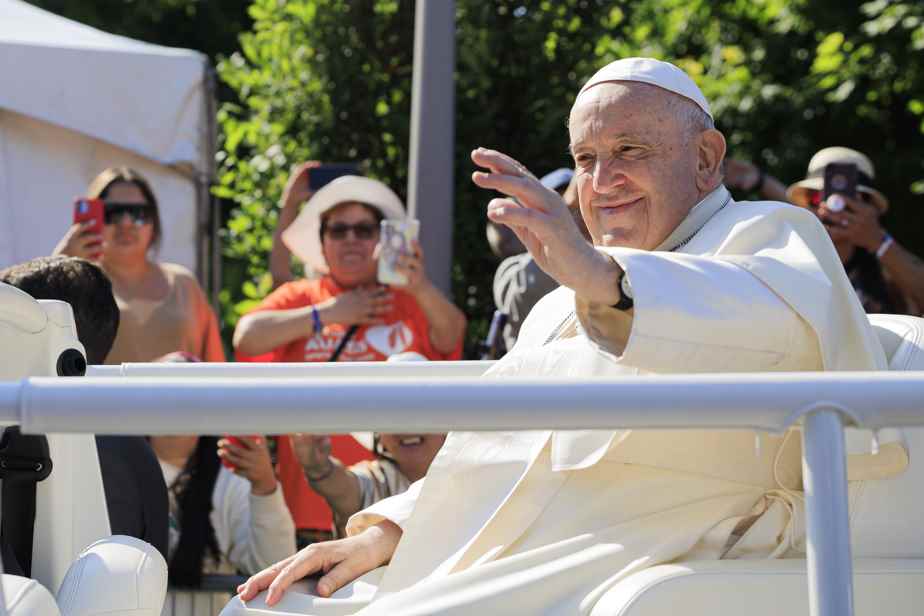(Sainte-Anne-de-Beaupré) On the fifth day of his penitent pilgrimage to Canada, Pope Francis enjoyed a walkabout before participating in a mass on the themes of reconciliation and healing at the Basilica of Saint Anne -de-Beaupre. He was greeted by a sparse crowd with mixed feelings.
Posted at 7:05 a.m.
Updated at 8:36 p.m.
The pope spoke of the disciples’ journey to Emmaus, at the end of Saint Luke’s Gospel, and the guilt they felt after the death of Jesus. He indicated that we could ask ourselves questions, ask ourselves “what happened? Why did this happen? How could this have happened? »
“These are the questions each of us asks ourselves; and these are also the burning questions that this pilgrim Church in Canada resounds in his heart on a trying journey of healing and reconciliation”, he declared in his mother tongue, Spanish, after speaking a few words in French to open Mass around 10 a.m. Thursday.
Inside the sanctuary, just in front of the altar and a few meters from Francis at the start of the mass, demonstrators unfurled a banner that read: “Annul the doctrine”, in reference to the papal edicts of 15e century that allowed European powers to colonize non-Christian lands and peoples.
A previous version of this text said that the pope had repeated in Sainte-Anne-de-Beaupré his apologies presented earlier this week. In fact, a replay of that apology took place on the big screen before he arrived at the basilica. They have been criticized in particular for having left aside the responsibility of the Church as an institution, and for not having mentioned the sexual assaults inflicted in the residential schools.
In the evening, however, Pope Francis finally recognized the sexual abuse inflicted on “minors and vulnerable people” during a homily delivered during evening prayer at the Notre-Dame-de-Québec cathedral basilica. The Holy Father mentioned that the fight against sexual abuse and other such “crimes” requires “firm action” and an “irreversible commitment”.
“The system is still there”
Met in Sainte-Anne-de-Beaupré, Lise Coocoo Dubé believes that these excuses are “a good thing”. “It was about time, I think,” added the one accompanying a delegation of elders and survivors from her community, Manawan. “I hope it will ease their suffering. »

PHOTO EDOUARD PLANTE-FRÉCHETTE, THE PRESS
Lise Coocoo Dube
“There’s a lot he didn’t mention,” said Abigail Brooks, a young woman from Sitansisk First Nation in New Brunswick. “There can be no reconciliation until all that has happened is acknowledged. She and her friend Stevie Hall-Polchies made the trip to “support our elders and all residential school survivors.”

PHOTO EDOUARD PLANTE-FRÉCHETTE, THE PRESS
Stevie Hall-Polchies (left) and Abigail Brooks
For Jimmy Peter Ainish, a survivor from the Naskapi community of Kawawachikamach, north of Schefferville, the apology is just the beginning. “The system is still there, it still takes our children away from us: it’s the youth protection system,” he denounced.

PHOTO EDOUARD PLANTE-FRÉCHETTE, THE PRESS
Jimmy Peter Ainish (center)
Before celebrating Mass, Pope Francis walked through a fenced path to greet the crowd of a few hundred gathered outside the basilica.
Organizers expected over 16,000 people to attend, but as with previous events in Quebec and Alberta, turnout was much lower. Nevertheless, there were many Aboriginal people there, often dressed in the orange of the “every child counts” movement in memory of the survivors of the residential schools and the children who were lost there.
Other Catholics of all origins had also come to see the sovereign pontiff. The Sainte-Anne-de-Beaupré site is one of the oldest and most popular pilgrimage sites in North America and attracts more than one million visitors each year.
Pope Francis also took part in Vespers – a prayer service – with Church leaders early Thursday evening at the Cathedral-Basilica of Notre-Dame de Québec. He is due to meet with a delegation of indigenous peoples on Friday morning before leaving for Iqaluit. The capital of Nunavut will be his last stop in Canada.
A translation error would have slipped into the speech
Organizers of the papal visit say the Vatican has “clarified” part of Pope Francis’ apology to residential school survivors, noting that an error occurred during translation.
The pontiff’s words near Edmonton this week raised questions when he said an important part of moving forward with the pardon request ‘will be to conduct a serious investigation into the facts of what happened. “.
Francis spoke Spanish and the apologies were translated into English.
Organizers of the papal visit said in a statement that the Vatican had ‘clarified’ that the English translation should have meant that survivors had heard the pope say that what was needed next was ‘serious research’, not a “serious investigation”.
Organizers say the pope has expressed a desire for Catholics to continue to seek truth and foster reconciliation.
They say Canadian bishops have also pledged to hand over documents that could help communities identify the remains of Indigenous children who would be buried in unmarked graves at former school sites.
With Agence France-Presse

